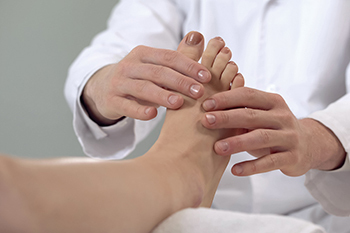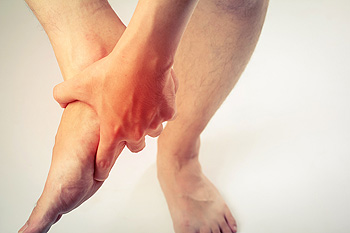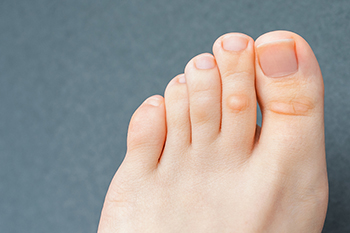September 2022
Causes and Effects of Drop Foot

Drop foot is caused by an inability to lift the foot enough to clear the ground as you take a step. It results in a shuffling or dragging type of gait. To counteract that, a person tends to over-lift the knees on each step, resembling a marching gait. Experts find that drop foot is usually a sign that something else is wrong. Causes may be anatomical, muscular, or neurological. Nerve injury, such as damage to the peroneal nerve, is a common cause of drop foot. Symptoms are pain and numbness. It may be brought on by a sports injury, childbirth, or sitting with your legs crossed for a long time. Certain muscle disorders like muscular dystrophy may also be the cause. Electronic imaging tests can be used to detect the underlying cause behind drop foot and treatment options depend on the source of the problem. Many find that custom orthotics, light braces, nerve stimulation, and possible surgery can be helpful. For more information on drop foot and how it may be treated, please consult a podiatrist.
If you have any concerns about your feet, contact Dr. Lee R. Stein from Lake Shore Foot & Ankle, PC. Our doctor can provide the care you need to keep you pain-free and on your feet.
Biomechanics in Podiatry
Podiatric biomechanics is a particular sector of specialty podiatry with licensed practitioners who are trained to diagnose and treat conditions affecting the foot, ankle and lower leg. Biomechanics deals with the forces that act against the body, causing an interference with the biological structures. It focuses on the movement of the ankle, the foot and the forces that interact with them.
A History of Biomechanics
- Biomechanics dates back to the BC era in Egypt where evidence of professional foot care has been recorded.
- In 1974, biomechanics gained a higher profile from the studies of Merton Root, who claimed that by changing or controlling the forces between the ankle and the foot, corrections or conditions could be implemented to gain strength and coordination in the area.
Modern technological improvements are based on past theories and therapeutic processes that provide a better understanding of podiatric concepts for biomechanics. Computers can provide accurate information about the forces and patterns of the feet and lower legs.
Understanding biomechanics of the feet can help improve and eliminate pain, stopping further stress to the foot.
If you have any questions please feel free to contact one of our offices located in Chicago, Highland Park, and Uptown, IL . We offer the newest diagnostic and treatment technologies for all your foot and ankle needs.
Possible Causes of Foot Pain

Foot pain can be disabling. When it hurts to walk, one’s quality of life can be greatly compromised. Foot pain can have many sources, including injury to bones, ligaments, nerves, or even skin. A few causes of foot pain are bunions, plantar fasciitis, and Morton’s neuroma. Bunions are ugly bulges on the metatarsophalangeal (MTP) joint at the base of the big toe that occur when this joint slips out of place. With this condition, the big toe gradually moves toward the other toes and can cause the bones to become deformed as they grow. Bunions can be painful, red, swollen, and numb. Plantar fasciitis is the most frequent cause of heel pain. The plantar fascia is the band of connective tissue that runs along the bottom of the foot. When it becomes inflamed, patients can experience significant pain in the heel or midfoot. This pain is often worse upon rising and decreases throughout the day. Morton’s neuroma develops when the tissue surrounding the nerve between the third and fourth toes thickens. This can cause mild to severe discomfort in the ball of the foot. Those with this condition often describe the sensation as standing on a marble or pebble. If you have pain in your feet, it is suggested that you visit a podiatrist for a proper diagnosis and begin effective treatment so you can be more comfortable.
Foot Pain
Foot pain can be extremely painful and debilitating. If you have a foot pain, consult with Dr. Lee R. Stein from Lake Shore Foot & Ankle, PC. Our doctor will assess your condition and provide you with quality foot and ankle treatment.
Causes
Foot pain is a very broad condition that could be caused by one or more ailments. The most common include:
- Bunions
- Hammertoes
- Plantar Fasciitis
- Bone Spurs
- Corns
- Tarsal Tunnel Syndrome
- Ingrown Toenails
- Arthritis (such as Gout, Rheumatoid, and Osteoarthritis)
- Flat Feet
- Injury (from stress fractures, broken toe, foot, ankle, Achilles tendon ruptures, and sprains)
- And more
Diagnosis
To figure out the cause of foot pain, podiatrists utilize several different methods. This can range from simple visual inspections and sensation tests to X-rays and MRI scans. Prior medical history, family medical history, and any recent physical traumatic events will all be taken into consideration for a proper diagnosis.
Treatment
Treatment depends upon the cause of the foot pain. Whether it is resting, staying off the foot, or having surgery; podiatrists have a number of treatment options available for foot pain.
If you have any questions, please feel free to contact one of our offices located in Chicago, Highland Park, and Uptown, IL . We offer the newest diagnostic and treatment technologies for all your foot care needs.
Complications of Corns

Corns are hardened spots of skin that can develop on the feet in response to pressure or friction. Specifically, corns develop on, near, and between the toes. Sometimes, corns can grow on an individual’s feet because their shoes are ill-fitting and too tight, causing the material to repeatedly rub up against the foot. This creates the kind of friction that causes corns. There are several complications associated with this particular foot affliction to be aware of. First, in severe cases of corns, the individual may experience a sensation of pain at the affected area. Having a particularly troublesome corn could also negatively impact your gait and capacity to walk or run. Severe cases of corns, if left unaddressed and untreated, might also lead to infections. Healthy tissues in and around the affected area on the foot could also be harmed or damaged by corns. If you have corns on your feet, contact a podiatrist and schedule an appointment today. This foot specialist can help you try to avoid these complications.
If you have any concerns regarding your feet and ankles, contact Dr. Lee R. Stein of Lake Shore Foot & Ankle, PC. Our doctor will treat your foot and ankle needs.
Corns: What Are They? and How Do You Get Rid of Them?
Corns can be described as areas of the skin that have thickened to the point of becoming painful or irritating. They are often layers and layers of the skin that have become dry and rough, and are normally smaller than calluses.
Ways to Prevent Corns
There are many ways to get rid of painful corns such as wearing:
- Well-fitting socks
- Comfortable shoes that are not tight around your foot
- Shoes that offer support
Treating Corns
Treatment of corns involves removing the dead skin that has built up in the specific area of the foot. Consult with Our doctor to determine the best treatment option for your case of corns.
If you have any questions please feel free to contact one of our offices located in Chicago, Highland Park, and Uptown, IL . We offer the newest diagnostic and treatment technologies for all your foot and ankle needs.
Broken and Sprained Ankles

The ankle is a necessary and critical part of the human body. The ankle joint allows the foot to move in different directions and makes walking and running possible. However, the ankle can be very susceptible to suffering from certain kinds of injuries. For example, broken ankles can be a serious threat to your health. Importantly, broken ankles are distinctly different from sprained ankles. When an individual breaks their ankle, the bones become essentially fractured. This is to say that bones such as the tibia, fibula, or talus can become fractured. If you have a broken ankle, you might experience several different symptoms. Commonly, an individual might experience feelings of pain or even swelling. Contrastingly, a person who sprains their ankle injures the ligaments surrounding the ankle, not the bones. When a person sprains their ankle the tissues become strained or overly stretched. Although these two injuries are different, it is possible to experience both at the same time in a very severe ankle injury. If you are worried about the health of your ankles, contact a podiatrist for more information about broken and sprained ankles.
Broken ankles need immediate treatment. If you are seeking treatment, contact Dr. Lee R. Stein from Lake Shore Foot & Ankle, PC. Our doctor can provide the care you need to keep you pain-free and on your feet.
Broken Ankles
A broken ankle is experienced when a person fractures their tibia or fibula in the lower leg and ankle area. Both of these bones are attached at the bottom of the leg and combine to form what we know to be our ankle.
When a physician is referring to a break of the ankle, he or she is usually referring to a break in the area where the tibia and fibula are joined to create our ankle joint. Ankles are more prone to fractures because the ankle is an area that suffers a lot of pressure and stress. There are some obvious signs when a person experiences a fractured ankle, and the following symptoms may be present.
Symptoms of a Fractured Ankle
- Excessive pain when the area is touched or when any pressure is placed on the ankle
- Swelling around the area
- Bruising of the area
- Area appears to be deformed
If you suspect an ankle fracture, it is recommended to seek treatment as soon as possible. The sooner you have your podiatrist diagnose the fracture, the quicker you’ll be on the way towards recovery.
If you have any questions, please feel free to contact one of our offices located in Chicago, Highland Park, and Uptown, IL . We offer the newest diagnostic and treatment technologies for all your foot care needs.
Reminder: When Was the Last Time...?
Blog Archives
- April 2025
- March 2025
- February 2025
- January 2025
- December 2024
- November 2024
- October 2024
- September 2024
- August 2024
- July 2024
- June 2024
- May 2024
- April 2024
- March 2024
- February 2024
- January 2024
- December 2023
- November 2023
- October 2023
- September 2023
- August 2023
- July 2023
- June 2023
- May 2023
- April 2023
- March 2023
- February 2023
- January 2023
- December 2022
- November 2022
- October 2022
- September 2022
- August 2022
- July 2022
- June 2022
- May 2022
- April 2022
- March 2022
- February 2022
- January 2022
- December 2021
- November 2021
- October 2021
- September 2021
- August 2021
- July 2021
- June 2021
- May 2021
- April 2021
- March 2021
- February 2021
- January 2021
- December 2020
- November 2020
- October 2020
- September 2020
- August 2020
- July 2020
- June 2020
- May 2020
- April 2020
- March 2020
- February 2020
- January 2020
- December 2019
- November 2019
- October 2019
- September 2019
- August 2019
- July 2019
- June 2019
- May 2019
- April 2019
- March 2019
- February 2019
- January 2019
- December 2018
- November 2018
- October 2018
- September 2018
- August 2018
- July 2018








